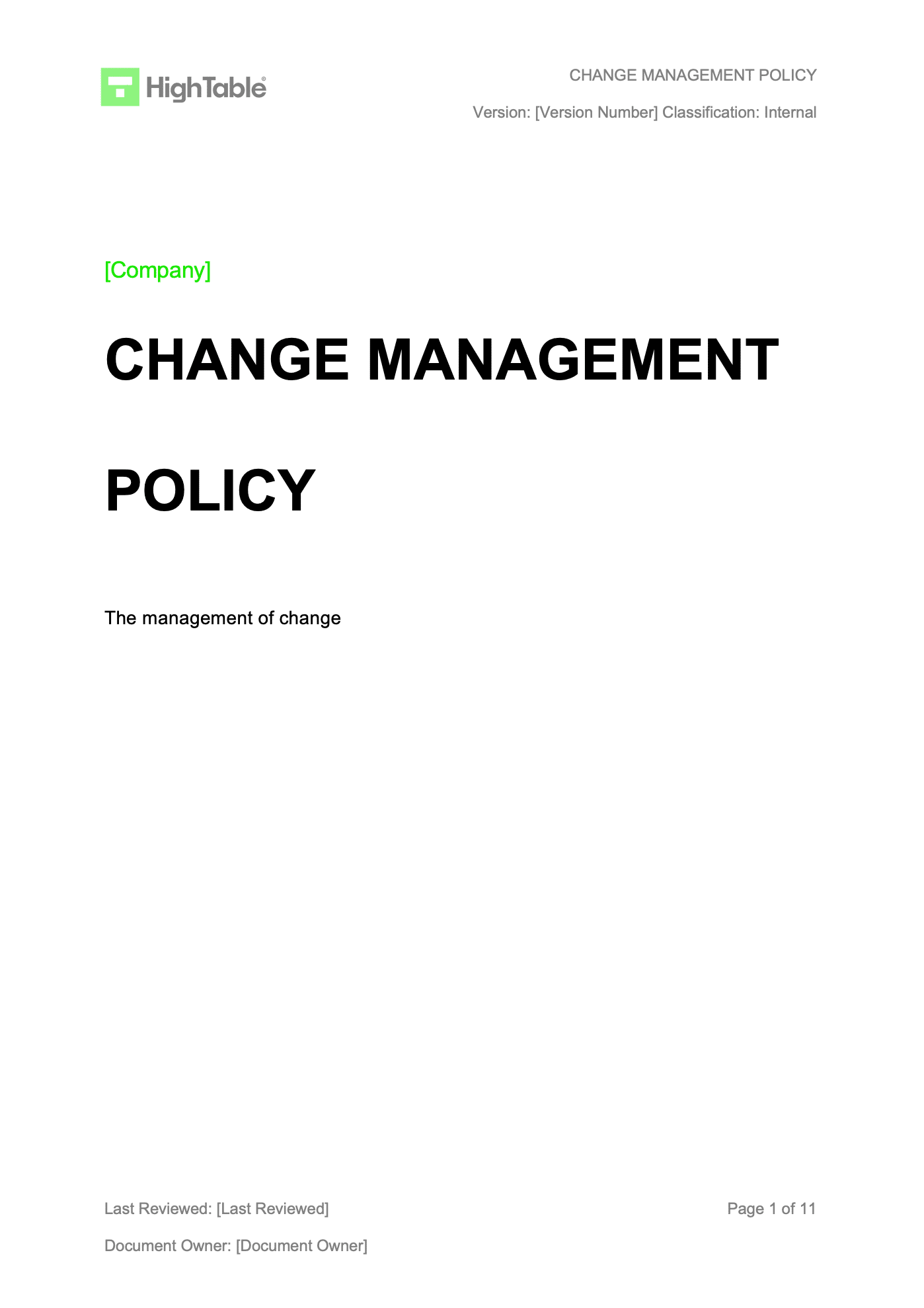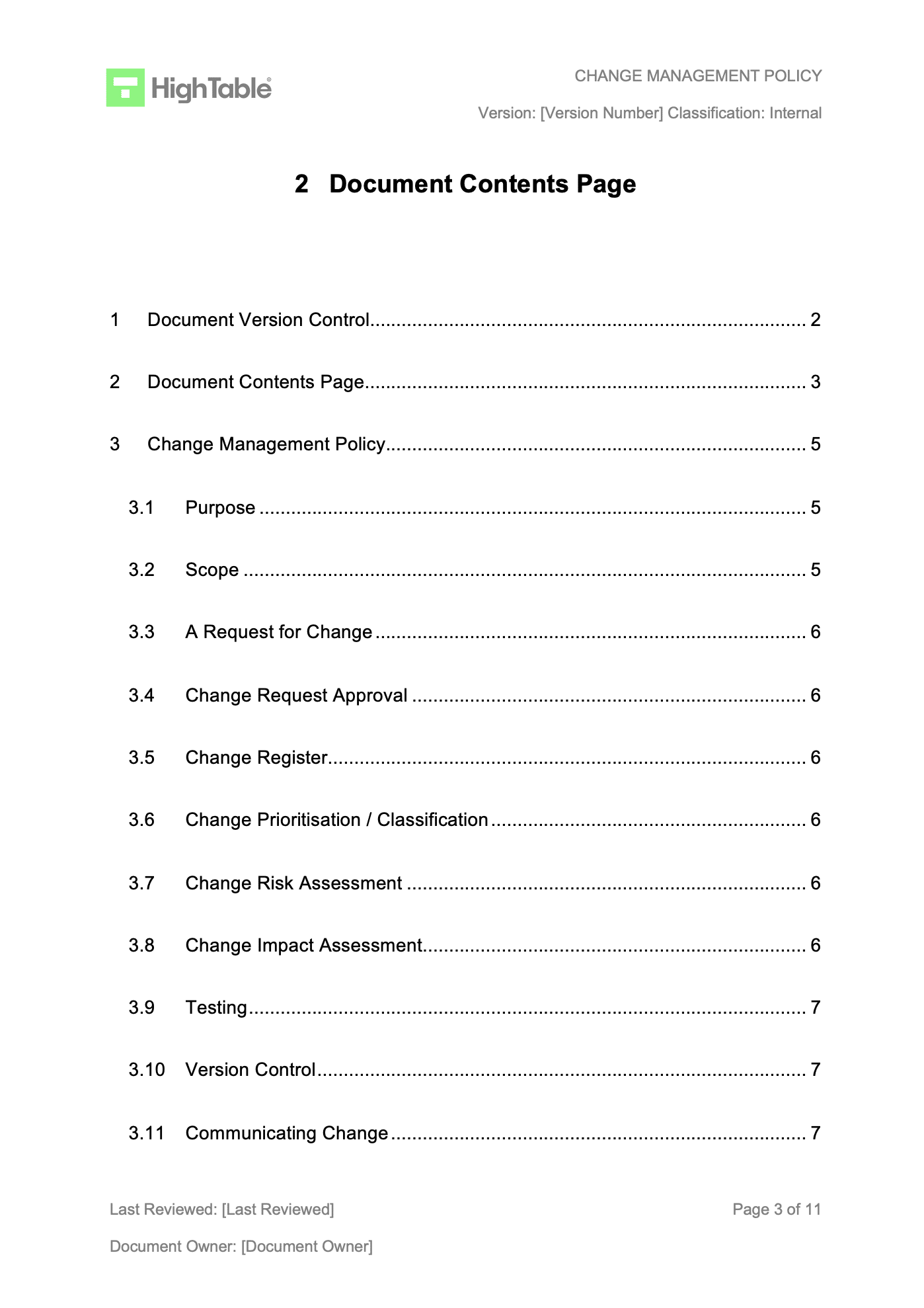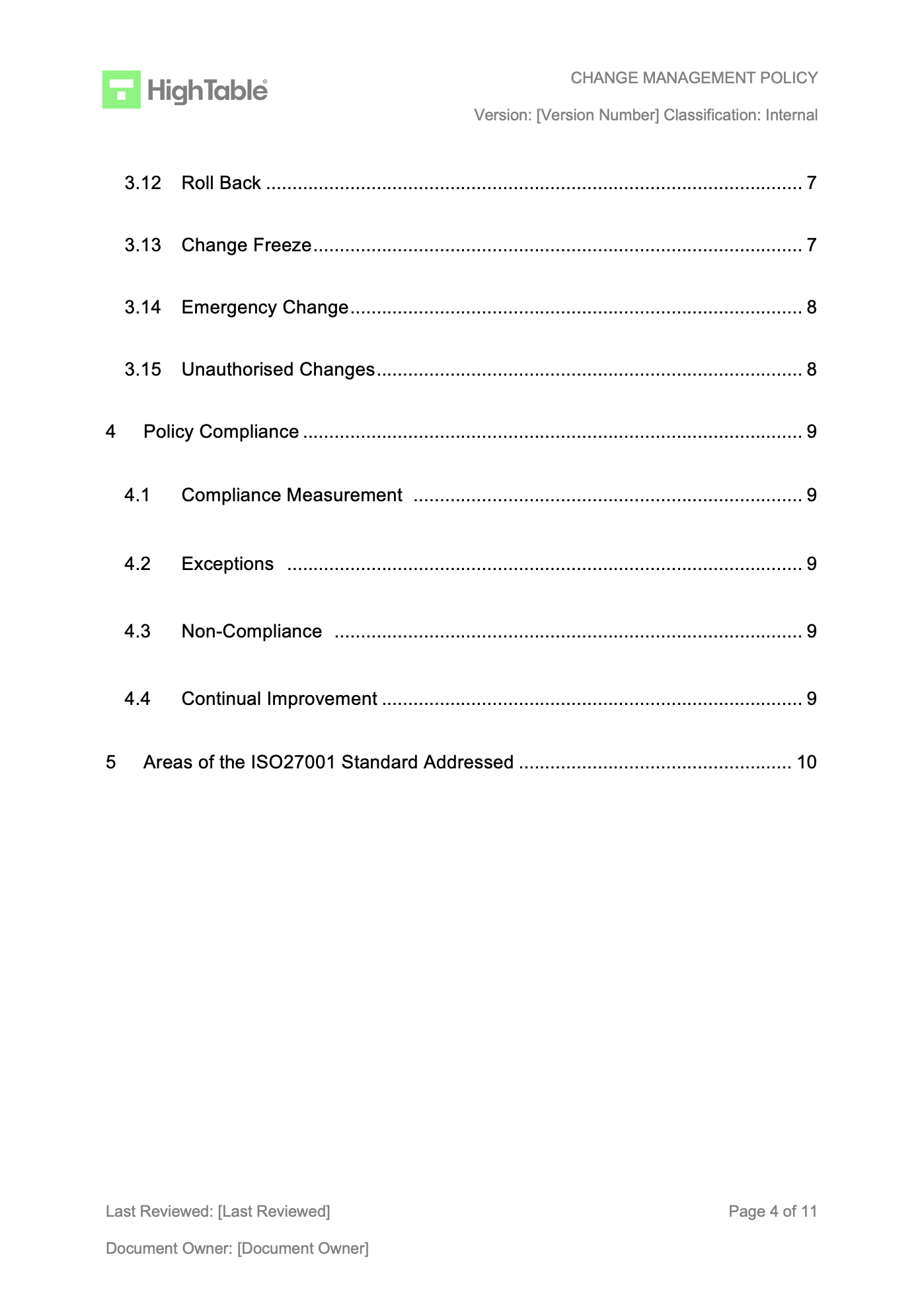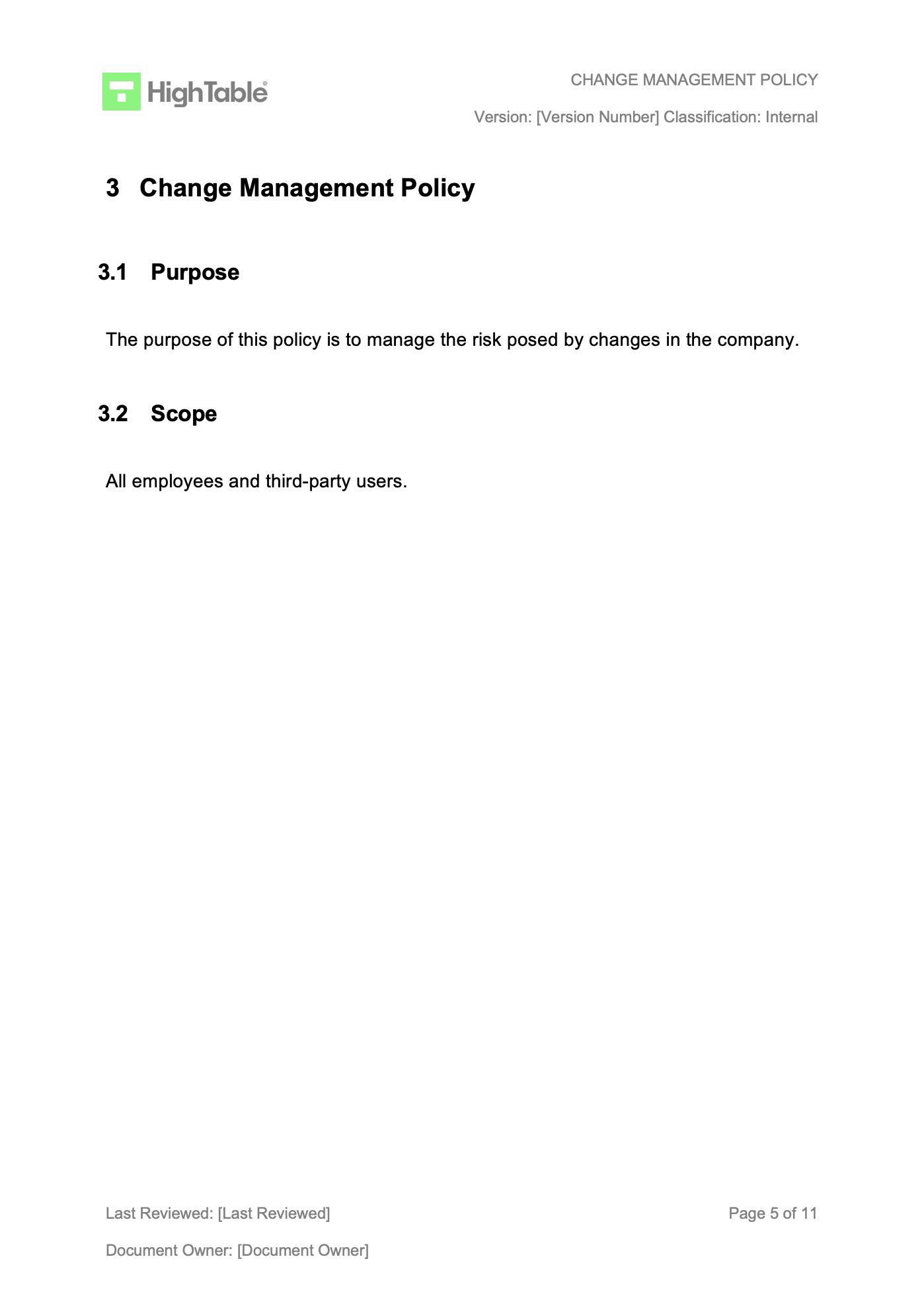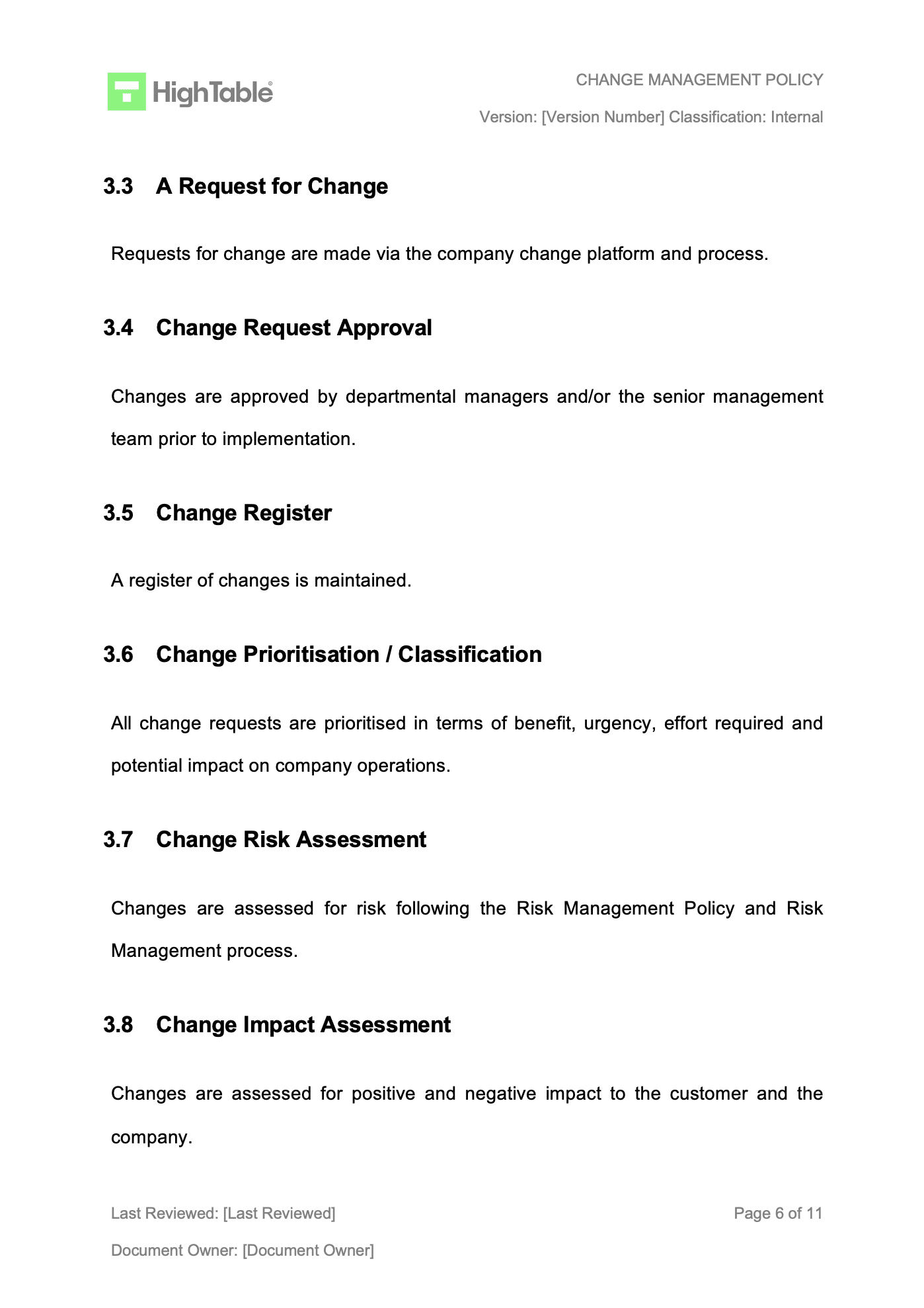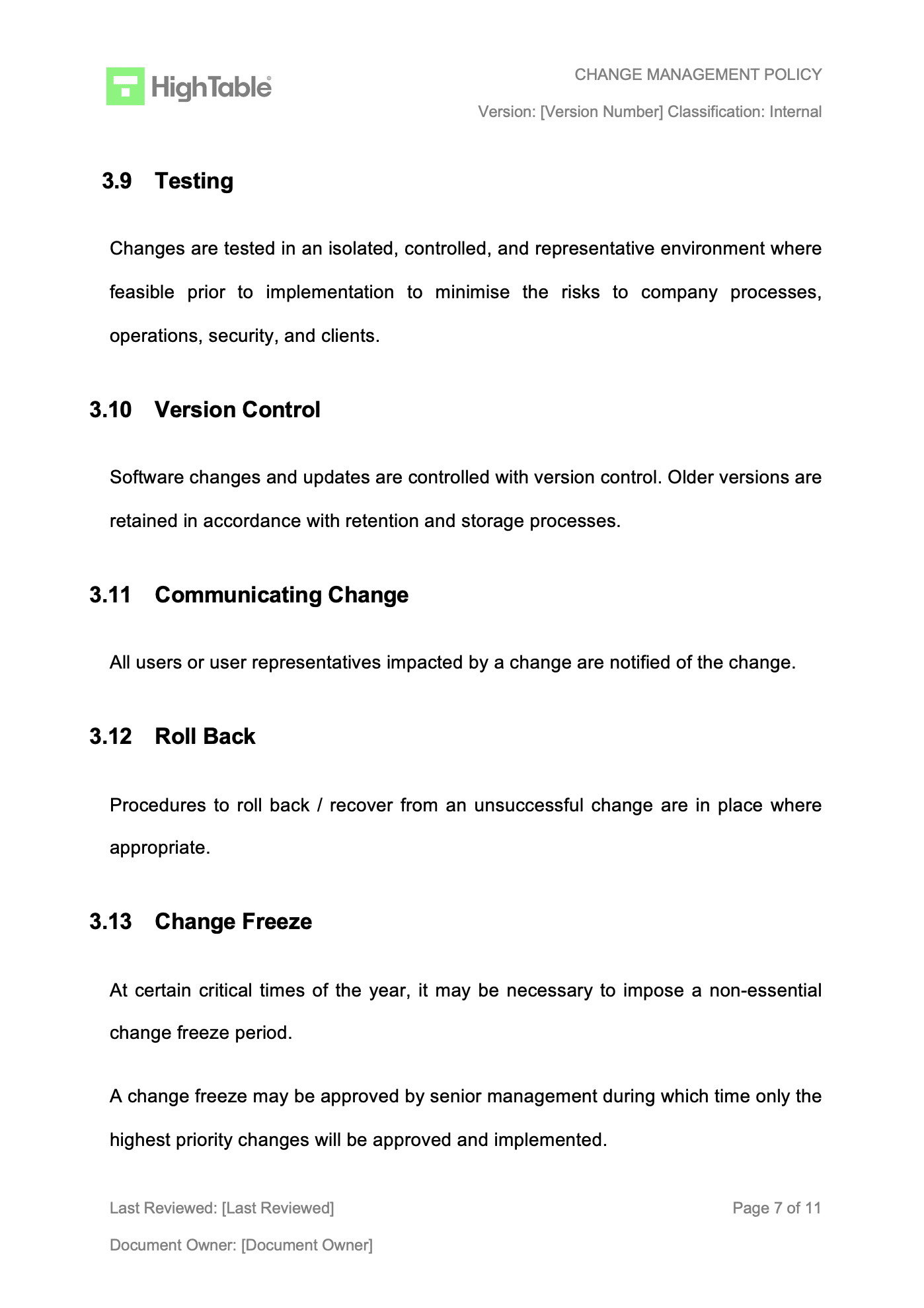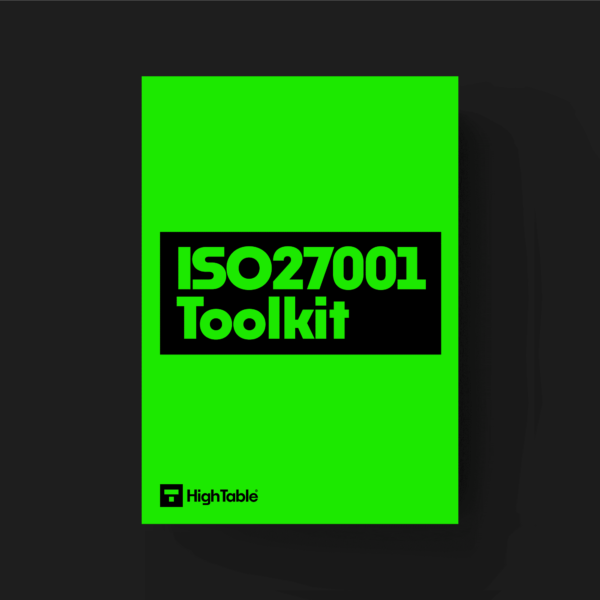ISO 27001 Change Management Policy Template
★★★★★ – Google 5-Star Reviews from Businesses Just Like You.
ISO 27001:2022 Change Management Policy
A pre-written, expert-vetted Change Management Policy designed for controlling system modifications and minimising security risks while ensuring full, auditor-ready compliance with ISO 27001:2022, NIS2, and DORA regulatory standards.
$ 7.98
Managing changes, big or small, can be a major headache, especially when you're trying to keep your data safe and sound. But what if there was a simple solution? What if you had a ready-made guide to help you navigate these changes while staying compliant with one of the world's most recognised security standards?
What is it?
So, what exactly is an ISO 27001 Change Management Policy Template? It’s a pre-written, ready-to-go document that provides a structured framework for managing all changes within your organisation's Information Security Management System. Think of it as a comprehensive rulebook that helps you handle changes in a way that minimises risks and ensures you meet the ISO 27001 standard. This template isn’t just a bunch of fancy words; it's a practical guide that outlines the steps, roles, and responsibilities for every type of change, from a simple software update to a major system overhaul. You can read a full guide in the ISO 27001 Change Management Policy Explained.
Is this template for you?
Yes, it is! This template is a perfect fit for:
- Small Businesses: You may think you're too small for this, but even a minor change can have a big impact. This template helps you establish good habits early on, ensuring your growth is secure.
- Tech Startups: In the fast-paced world of startups, things change constantly. This template provides the structure you need to manage agile development and frequent updates without compromising security.
- AI Companies: For companies dealing with sensitive data and complex algorithms, managing changes is a non-negotiable. This template helps you track and approve changes to your models and data, protecting your valuable intellectual property and customer data.
Why do you need an ISO 27001 Change Management Policy Template?
You need this template because it’s the easiest way to get your change management process right the first time. It provides a clear, step-by-step guide to help you:
- Meet ISO 27001 Requirements: The standard specifically requires a formal policy for managing changes. This template gives you exactly that, helping you tick a major box during your Audit.
- Minimise Security Risks: Uncontrolled changes are a hacker’s best friend. This policy ensures every change is assessed for security risks, helping you prevent breaches before they happen.
- Improve Efficiency: Instead of reinventing the wheel every time you make a change, this template provides a consistent policy, saving you time and headaches.
- Build Trust: A well-defined change management policy shows your customers and partners that you take security seriously, boosting your reputation and credibility.
When do you need an ISO 27001 Change Management Policy Template?
You need this template as soon as you decide to pursue ISO 27001 Certification or when you're looking to mature your information security practices. If you're experiencing any of these, it's time to get a template:
- Your team is making changes without any formal approval process.
- You're not sure how a recent change affected your security posture.
- You're preparing for an ISO 27001 audit and need to demonstrate a robust change management process.
- Your business is growing and you need a scalable way to handle changes.
Who needs this template?
Everyone involved in your information security management system needs this template. This includes:
- The ISMS Manager: The person responsible for the overall ISMS.
- System Administrators: They're the ones making the changes.
- Developers: They need to follow the process when deploying new code.
- Project Managers: They need to factor in the change management process into their project plans.
- Senior Management: They need to approve major changes and understand the risks.
Where do you need to use this policy?
You'll use this policy in every part of your organisation where a change could impact information security. This includes:
- IT infrastructure: Upgrading servers, network devices, or firewalls.
- Software Development: Releasing a new feature or a bug fix.
- Business Processes: Changing a procedure for handling customer data.
- Physical Security: Installing a new lock on a server room door.
How do you write it?
Writing a change management policy from scratch can be tough. The template makes it super easy! It provides the structure, you just need to fill in the blanks with details specific to your business. This includes:
- Defining what a 'change' is in your company.
- Outlining the roles and responsibilities of the people involved.
- Describing the steps of your change management process (e.g., request, review, approval, implementation, and review).
- Specifying the tools you’ll use to track changes.
How do you implement it?
Implementing the policy is a process in itself. Start by customising the template to fit your business. Then, follow these steps:
- Communicate: Hold a meeting or send out an email to inform everyone about the new policy.
- Train: Conduct a brief training session to teach your team how to use the policy.
- Use a Tool: Implement a tool like a change management system or a simple spreadsheet to track changes.
- Enforce: Make sure everyone is following the new process for every single change, no matter how small.
- Review: Regularly review and update the policy to ensure it remains relevant to your business.
Let's see some examples!
Small Business Example
Imagine you run a small e-commerce site. You decide to switch your payment processor. This is a big change! Using the template, you'd:
- Request: Your IT manager fills out a change request form.
- Review: Your business owner and IT manager review the security implications of the new processor.
- Approve: The business owner approves the change.
- Implement: The IT manager implements the new payment processor.
- Review: You test the new system to ensure it's working correctly and securely.
Tech Startup Example
You're a tech startup that just built a new feature. You need to push it live. Using the template, you'd:
- Request: A developer creates a change request ticket in your project management software.
- Review: Your lead developer and security expert review the code for any vulnerabilities.
- Approve: The lead developer approves the code for deployment.
- Implement: The code is deployed to the production environment.
- Review: A post-implementation review confirms the feature is working as expected and hasn't introduced any security flaws.
AI Company Example
Your team has created a new, more efficient machine learning model. Using the template, you'd:
- Request: Your data scientist submits a change request to replace the old model with the new one.
- Review: The data governance committee reviews the new model to ensure it doesn't introduce bias or new security risks.
- Approve: The committee approves the model.
- Implement: The IT team deploys the new model into production.
- Review: The performance of the new model is monitored, and a post-implementation review confirms it is operating as expected.
How the ISO 27001 toolkit can help
Our ISO 27001 toolkit is a game-changer! It's not just a single template; it's a complete collection of policies, procedures, and forms that cover all the requirements of the ISO 27001 standard. The toolkit helps you:
- Save time by providing a complete set of documents.
- Ensure consistency across all your security policies.
- Streamline your ISO 27001 certification journey.
What other security standards need a change management policy?
A change management policy is a fundamental part of any good information security framework. It’s not just for ISO 27001! You'll also need a change management policy for:
- NIST: This framework requires organisations to manage changes to systems and assets.
- SOC 2: A change management policy is a key part of the Security and Availability Trust Services Criteria.
- GDPR: While not a specific requirement, a good change management process helps you ensure that changes to systems that handle personal data comply with GDPR rules.
Relevant ISO 27001:2022 Controls
A change management policy is a requirement for ISO 27001:2022 Annex A 8.32: Change Management. It is useful for The Ultimate Guide to ISO 27001:2022 Annex A 5.22 Monitor, Review And Change Management Of Supplier Services. You'll also need a change management policy for:
For Small Businesses
- The Ultimate Guide to ISO 27001:2022 Annex A 8.27: Secure Systems Architecture and Engineering Principles: This control emphasises integrating security into projects, which often involve changes.
For Tech Startups
- The Ultimate Guide to ISO 27001:2022 Annex A 8.25: Secure Development Life Cycle: This control ensures that security is baked into the entire software development process, from coding to deployment.
For AI Companies
- The Ultimate Guide to ISO 27001:2022 Annex A 8.27: Secure Systems Architecture and Engineering Principles: This is a new control that focuses on managing security risks in AI systems, including changes to those systems.
15 Change Management Policy Template FAQs
- What is a change management policy? A set of rules and procedures for how your organisation handles changes to its systems and data.
- Why is it important for ISO 27001? It’s a mandatory requirement to ensure changes don’t compromise your security.
- Can I use this template for non-IT changes? Yes, it’s designed to be flexible and can be used for any change that affects information security.
- How often should I review the policy? At least annually, or whenever your business undergoes a major change.
- Is this template a complete solution for ISO 27001? No, it’s one key document. You’ll need a full toolkit to cover all requirements.
- Do I need a special tool for change management? Not necessarily. You can start with a simple spreadsheet and move to more advanced software later.
- What if a change is an emergency? The template includes a section on handling emergency changes while still maintaining a record.
- Does this policy cover changes to our cloud provider? Yes, any change to your IT environment, including a cloud provider, should be managed under this policy.
- How do I make sure my team follows the policy? Communication and training are key. You also need to enforce the policy consistently.
- What is the difference between a policy and a procedure? The policy states what you do, while the procedure explains how you do it.
- Do I need to track every single change? Yes, for ISO 27001, you must maintain a record of all changes and their approvals.
- Is this template specific to a certain industry? No, it's a general framework that can be adapted for any industry.
- Can I use this template if I don't want to get certified? Absolutely! It's a great way to improve your security posture regardless of certification.
- How long does it take to implement this policy? It depends on the size of your organisation, but you can get it up and running in a few weeks.
- Is the change management policy a live document? Yes, it should be reviewed and updated regularly to stay relevant.
The High Table ISO 27001 Implementation Suite was architected by Stuart Barker, a veteran practitioner with over 30 years of experience in systems security and risk management.
Holding an MSc in Software and Systems Security, Stuart combines academic rigor with extensive operational experience. His background includes over a decade leading Data Governance for General Electric (GE) across Europe, as well as founding and exiting a successful cyber security consultancy.
As a qualified ISO 27001 Lead Auditor and Lead Implementer, Stuart possesses distinct insight into the specific evidence standards required by certification bodies. He has successfully guided hundreds of organizations—from high-growth technology startups to enterprise financial institutions—through the audit lifecycle.
This toolkit represents the distillation of that field experience into a standardised framework. It moves beyond theoretical compliance, providing a pragmatic, auditor-verified methodology designed to satisfy ISO/IEC 27001:2022 while minimising operational friction.


